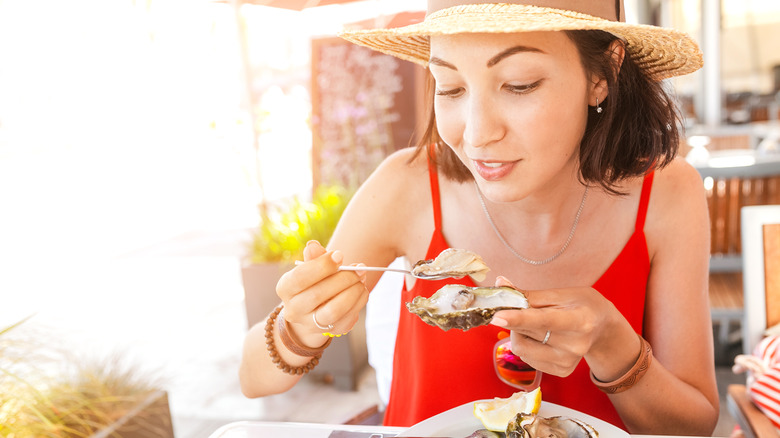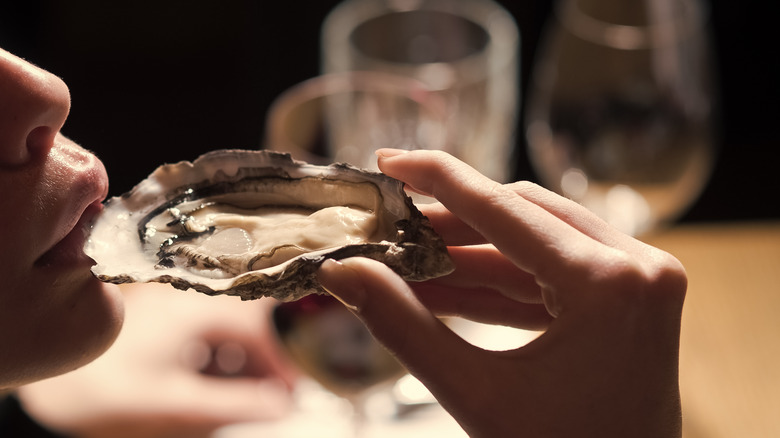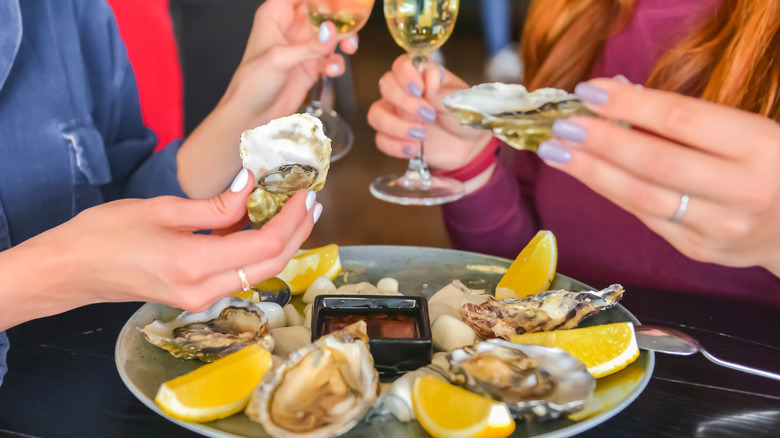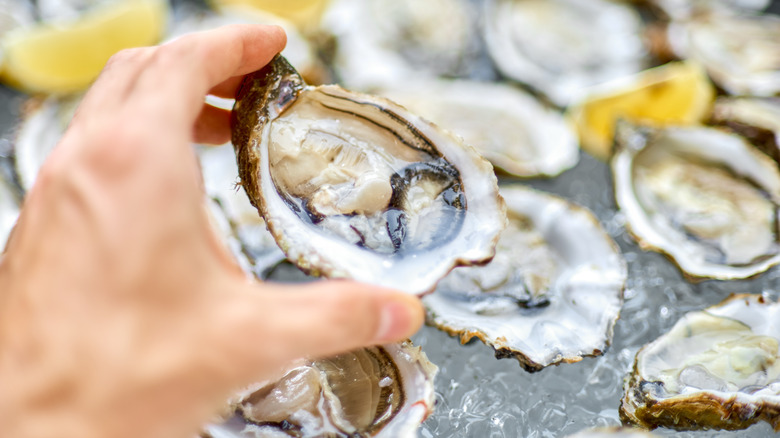Um, Should We Be Skipping Our Summer Oyster Habit? Here's What To Know
Slurping down tasty ocean goodness is all the fun in the world until you have your head down a toilet bowl cursing every crustacean to ever exist. If you have heard of the "oysters are only safe to eat in the R months" rule, but are highly skeptical of the logic behind it, we're here to break it down for you.
Eating oysters can feel like a gamble; they contain vitamins especially vitamin B12, per Web MD, and lots of micronutrients, including Iron and magnesium, making them a pretty healthy choice. But one wrong move, or in this case, one wrong oyster, and you'll be so sick you may swear them off forever. It's a gamble but can pay off if you know the risks and how to select your oysters.
Sadly the hot summer months of June, July, and August have no Rs in them, so a platter of oysters paired with a chilled glass of your go-to summer drink is a complete no-no. But is it? Do you really have to give up on this briney goodness just because it's summer? Well, we're going to help you decide.
What could possibly go wrong?
If you're not a fan of throwing up, abdominal cramps, and nausea, vibriosis is not the disease for you. And that is exactly what a bad oyster can do to you. Eating uncooked or raw oysters puts you at risk of ingesting a bacteria named "vibrio." Oysters who happily filter water invite and retain this bacteria in their system. We eat these oysters, and vibrio, the unwelcome guest, wreaks havoc in our systems.
In addition to all the pains of food poisoning, vibriosis can also cause death. That's right, one bad oyster and it could be the end. In fact, according to the Centers for Disease Control and Prevention, one-in-five people with a vibrio infection can die, so may the odds be ever in your favor. The infection can worsen from symptoms of food poisoning to bloodstream infections, severe blistering, and even limb amputations. Yes, scary, we know. People who have liver disease, cancer, high stomach acidity, diabetes, or are 65 or older are more likely to have the most severe symptoms of vibriosis.
Why say yes to oysters in the summer?
The summer is when the oysters start their spawning. As fun as this may sound, the reproducing oyster is thin and watery. So, if you're looking for that juicy plump goodness, avoid summertime oysters. Furthermore, rising temperatures promote bacteria growth. The higher the bacteria in the water, the higher your chances of getting vibriosis, so deny yourself that oyster platter when the months aren't spelled with an R.
But the summer-time "R" rule, which may be as old as 4,000 years old, according to The University of Florida, doesn't apply as much today as it once did. Today, with farmed oysters, very strict rules are in place to ensure water quality and safety standards. It's not a perfect system, and farmed oysters are still grown in natural bodies of water toward the later part of their growth cycle, but your odds are better with farm-raised than wild-caught oysters in the summer months thanks to all the oversight. Another big reason oysters in the summer are safer than they used to be is that we have refrigeration and ice at the ready. Mike Osinski, of the Widow's Hole Oyster Farm in Greenport, N.Y. told The New York Times, "There are strict icing laws in the summer to instantly reduce temperatures at harvest."
Still, here's a bit of not-so-comforting information: a bad oyster or an oyster with the vibrio bacteria doesn't look or smell any different from a good oyster. If you're not one to take risks, we suggest cooking your oysters to kill off any bacteria.
Selecting your oysters
All that said, if you're quite the daredevil and want to enjoy that refreshingly salty taste with just a dash of lemon, here's how to minimize the risk of food poisoning. Buy your oysters from good reputable sources, check the labels, and make sure the oysters are farmed in clean waters and are properly refrigerated. Some farmed oysters have even been bred to be sterile, so, you can have deliciously fleshy oysters all year round. Another thing to look out for when buying oysters is how heavy they are; heavy oysters are green flags, while light ones should be avoided.
So, when you finally get to the eating part, if you are shucking oysters at home, be sure to check the harvest date on the label and eat your oysters within a week from that date during the summer and within 10 days during the winter. If dining out, you can always ask your server or the shucker for information about the oysters, including where they're from and when they were harvested.
Should we be skipping our summer oyster habit? Not as long as you know which oysters to buy, how to eat them, when to eat them, and the risks involved. So, for a summer of slurping oysters by the beach, simply prepare yourself and hope for the best.



